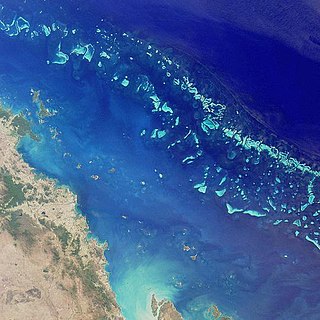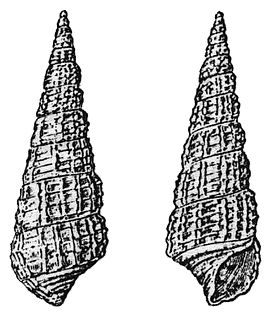
Marine biology is the scientific study of marine life, organisms in the sea. Given that in biology many phyla, families and genera have some species that live in the sea and others that live on land, marine biology classifies species based on the environment rather than on taxonomy.
Genus is a taxonomic rank used in the biological classification of living and fossil organisms as well as viruses, in biology. In the hierarchy of biological classification, genus comes above species and below family. In binomial nomenclature, the genus name forms the first part of the binomial species name for each species within the genus.

Marine mammals are aquatic mammals that rely on the ocean and other marine ecosystems for their existence. They include animals such as seals, whales, manatees, sea otters and polar bears. They are an informal group, unified only by their reliance on marine environments for feeding and survival.

The Great Barrier Reef is the world's largest coral reef system composed of over 2,900 individual reefs and 900 islands stretching for over 2,300 kilometres (1,400 mi) over an area of approximately 344,400 square kilometres (133,000 sq mi). The reef is located in the Coral Sea, off the coast of Queensland, Australia. The Great Barrier Reef can be seen from outer space and is the world's biggest single structure made by living organisms. This reef structure is composed of and built by billions of tiny organisms, known as coral polyps. It supports a wide diversity of life and was selected as a World Heritage Site in 1981. CNN labelled it one of the seven natural wonders of the world. The Queensland National Trust named it a state icon of Queensland.

The gastropods, commonly known as snails and slugs, belong to a large taxonomic class of invertebrates within the phylum Mollusca called Gastropoda.
The pelagic zone consists of the water column of the open ocean, and can be further divided into regions by depth, as illustrated on the right. The word "pelagic" is derived from Ancient Greek πέλαγος (pélagos) 'open sea'. The pelagic zone can be thought of in terms of an imaginary cylinder or water column that goes from the surface of the sea almost to the bottom. Conditions in the water column change with distance from the surface (depth): the pressure increases; the temperature and amount of light decreases; the salinity and amount of dissolved oxygen, as well as micronutrients such as iron, magnesium and calcium, all change.

Isopoda is an order of crustaceans that includes woodlice and their relatives. Isopods live in the sea, in fresh water, or on land. All have rigid, segmented exoskeletons, two pairs of antennae, seven pairs of jointed limbs on the thorax, and five pairs of branching appendages on the abdomen that are used in respiration. Females brood their young in a pouch under their thorax.

Marine conservation, also known as ocean conservation, is the protection and preservation of ecosystems in oceans and seas through planned management in order to prevent the over-exploitation of these resources. Marine conservation is informed by the study of marine plants and animal resources and ecosystem functions and is driven by response to the manifested negative effects seen in the environment such as species loss, habitat degradation and changes in ecosystem functions and focuses on limiting human-caused damage to marine ecosystems, restoring damaged marine ecosystems, and preserving vulnerable species and ecosystems of the marine life. Marine conservation is a relatively new discipline which has developed as a response to biological issues such as extinction and marine habitats change.

Heterodonta is a taxonomic subclass of saltwater clams, marine bivalve molluscs. This subclass includes the edible clams, the cockles and the Venus clams.

Cerithiidae, common name the cerithiids or ceriths, is a large family of medium-sized marine gastropods in the clade Sorbeoconcha.

Corallimorpharia is an order of marine cnidarians closely related to stony or reef building corals (Scleractinia). They occur in both temperate and tropical climates, although they are mostly tropical. Temperate forms tend to be very robust, with wide and long columns, whereas tropical forms tend to have very short columns with a wide oral disc and very short tentacles. The tentacles are usually arranged in rows radiating from the mouth. Many species occur together in large groups, although there are recorded instances of individuals. In many respects, they resemble the stony corals, except for the absence of a stony skeleton. Morphological and molecular evidence suggests that they are very closely related to stony corals.
The World Register of Marine Species (WoRMS) is a taxonomic database that aims to provide an authoritative and comprehensive list of names of marine organisms.

Bittium is a genus of very small sea snails, marine gastropod molluscs in the family Cerithiidae, the horn snails.

Freshwater snails are gastropod mollusks which live in fresh water. There are many different families. They are found throughout the world in various habitats, ranging from ephemeral pools to the largest lakes, and from small seeps and springs to major rivers. The great majority of freshwater gastropods have a shell, with very few exceptions. Some groups of snails that live in freshwater respire using gills, whereas other groups need to reach the surface to breathe air. In addition, some are amphibious and have both gills and a lung. Most feed on algae, but many are detritivores and some are filter feeders.
Ittibittium houbricki is a species of sea snail, a marine gastropod mollusk in the family Cerithiidae.
Ittibittium oryza is a species of sea snail, a marine gastropod mollusk in the family Cerithiidae.
Ittibittium parcum is a species of sea snail, a marine gastropod mollusk in the family Cerithiidae.
Ittibittium is a genus of very small sea snails, marine gastropod mollusks in the family Cerithiidae.

Plesiotrochus is a genus of sea snails, marine gastropod mollusks in the family Plesiotrochidae.

Heteropsammia is a genus of apozooxanthellate corals that belong to the family Dendrophylliidae.











